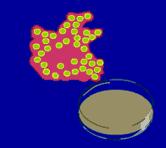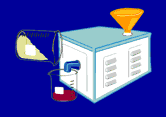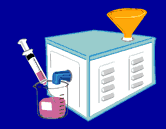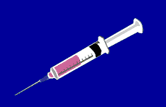|
 Step 1
Step 1
Use the tissue culture to grow new viruses.
|
|
The goal in creating a killed vaccine is to disable
a pathogen's replicating ability (its ability to
enter cells and multiply) while keeping intact its
shape and other characteristics that will generate
an immune response against the actual pathogen. When
the body is exposed to the killed polio vaccine, its
immune system will set up a defense that will attack
any live polio viruses that it may encounter later.
To produce this vaccine, you first need many copies
of the polio virus. You can grow these in a tissue
culture.
|
|
 Step 2
Step 2
Use the purifier to isolate the polio viruses.
|
|
The polio virus uses the cells within the tissue
culture to produce many copies of itself.
These copies of the virus need to be separated from
the tissue culture.
|
|
 Step 3
Step 3
Use formaldehyde to kill the viruses.
|
|
There are several ways to inactivate a virus or
bacteria for use in a vaccine. One way is to expose
the pathogen to heat. This is how the bacteria in
the typhoid vaccine is inactivated. Another way is
to use radiation.
For the polio vaccine developed by Jonas Salk in
1954, formaldehyde was used. You'll use formaldehyde
in creating your polio vaccine, too.
|
|
 Step 4
Step 4
Fill the syringe with the killed polio virus.
|
|
The dead viruses in your polio vaccine will not
produce a full immune response when injected in a
body. This is true for all vaccines that are not
live. For this reason, these vaccines usually
require booster shots.
|
|
 Done
Done
The polio vaccine is complete.
Select another pathogen.
|
|
Congratulations. You have produced a killed polio
vaccine.
There are two polio vaccines widely used today. One
is Salk's killed vaccine; the other is a
live-attenuated vaccine first developed by Albert
Sabin.
In addition to polio and typhus, killed vaccines are
used to prevent influenza, typhoid, and rabies.
|
|